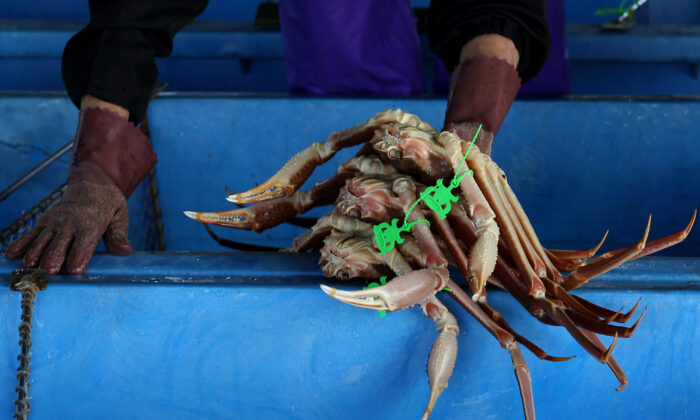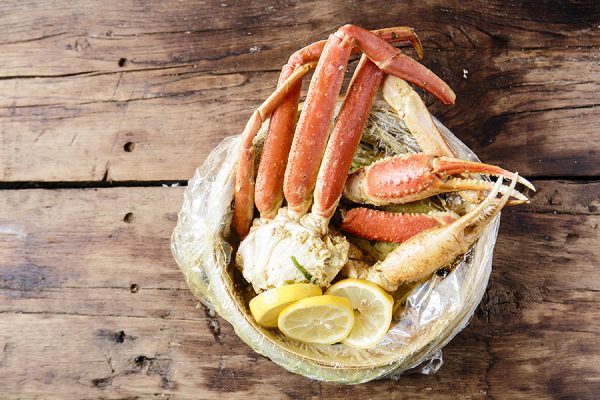We now get to see how they spawn back. a multiyear recovery would tell us that something bad happened. We can be pretty sure they were not overfished unless it was possible for pirate ships to come in somehow.
right now we are confounded.. .
Alaskan Snow Crab Fishery Closed as Canada, Russia Report Bumper Harvests
By Melanie Sun
October 16, 2022 Updated: October 16, 2022
A woman holds a set of freshly caught snow crabs prior to first day crab auction at a Kasumi commercial fishing port in Kasumi, Hyogo Prefecture, Japan, on Nov. 6, 2020. (Buddhika Weerasinghe/Getty Images)
https://www.theepochtimes.com/alaskan-snow-crab-fishery-closed-as-canada-russia-report-bumper-harvests_4799352.html
Alaskan crabbers and their communities are facing another difficult year after regulators announced that the East Bering Sea will be closed for the 2022 season to snow crab fishing.
“The Bering Sea snow crab fishery is closed for the first time ever,” Jamie Goen, executive director of Alaska Bering Sea Crabbers, said in a statement. “Second and third generation crab-fishing families will go out of business due to the lack of meaningful protections by decision-makers to help crab stocks recover.”
Meanwhile, eastern Canada’s snow crab fishery in the Labrador Sea reported bumper harvests of snow crabs this year, with processors unable to keep up with the workload.
Catch quotas for Alaska’s yearly harvest in the East Bering are set every September according to limits set by a federal management plan, and advice from NOAA’s National Marine Fisheries Service, referencing the results of the agency’s annual Bering Sea bottom trawl survey and other stock monitoring data.
On Oct. 10, communities were told (pdf) by the Alaska Department of Fish and Game that their snow crab industry, which had anticipated a $200 million 2022 harvest, would be entirely closed for the 2022–2023 season, following big quota cuts in 2021. The department cited stock estimates “below the ADF&G regulatory threshold for opening a fishery.”
The Bristol Bay red king crab harvest was also declared closed for the second year in a row. In October 2021, the department for the first time since the 1990s banned harvests for the entire king crab season. Their Alaskan populations have been in a slow decline over the last decade.
Crabs, which are caught direct from the seabed in pots, are Alaska’s third most valuable fishery. There are three big remaining crab fisheries in the Bering Sea; the 2 to 4 pound snow crab, the 20 pound Red King Crab, and less sought-after Tanner crab—all of which are reportedly in decline.
Snow crabs, which are smaller than their King crab cousins, have thinner shells, which make them easier to crack to access their sweet, briny meat by hand.
Snow crab legs. (Samira Bouaou/Epoch Times)
Mass Mortality Event?
Management of Alaska’s snow crab populations had been thought to be quite successful until they unexpectedly took a nosedive in 2021.
Unfortunately, many locals were planning for a massive snow crab harvest in 2021 after scientists reported in 2018 and 2019 that record numbers of juvenile crabs had been seen swimming around on the ocean floor.
But it wasn’t to be. Quotas were dramatically cut in 2021 by almost 90 percent after NOAA reported a population bust, declaring snow crabs in the East Bering Sea overfished. The crash was considered a “mysterious mortality event.”
The cause of the crash is still unknown. Scientists have presented a range of theories; that the crabs have moved into Russian waters in the western Bering Sea or further north, were killed as bycatch in trawler fisheries, died from disease in the warmer waters or from changes in salinity, or were more exposed to predators in the warmer waters. There were known shifts in the food chain in 2022, with scientists reporting the largest run of Bristol Bay Sockeye Salmon on record.
Now, crab-dependent communities are devastated, with blue-collar workers and small family businesses hit the worst, bracing for another year of lost crabbing revenue. While the U.S. Department of Commerce has directed nearly $132 million to Alaska for the fisheries disaster, the money won’t reach impacted families and their communities for many years, Goen said.
In 2020, commercial landings of Alaskan snow crab totaled more than 36.6 million pounds and were valued at more than $101.7 million, according to NOAA Fisheries’ commercial fishing landings database. But populations have declined since 2019, coinciding with warming in the Bering Sea with changes in the Arctic Oscillation. In 2021, the harvest of 5.6 million pounds was the smallest in over 40 years.
Canada is the world’s largest producer of snow crab. In 2022, its snow crab fishery increased its total allowable catch by 32 percent to an over 111 million pound harvest. Russia, in second place, harvested 103 million pounds of snow crab in 2022, mostly in the Barents Sea.
The Biden administration banned imports of Russian seafood products in March, which saw Russian snow crab imports curbed and global prices drop.
Alaska’s ‘Rationing’
The prized Alaskan crab fisheries is managed by one of the most involved systems in the world. Run by the North Pacific Fishery Management Council, the crab fisheries were “rationalized” in 2005 with the aim of protecting the fisheries from overfishing and ensuring sustainable harvests. The rationalizing split fishing effort between existing harvesters based on their past catch history.
But what has unfolded in reality has been anything but that intended outcome, Goen told the council in September in a letter of concern.
Under the council’s stewardship, the rationalized snow crab fishery in Alaska has collapsed—with other crab species also in continued rapid decline. The council has promised to improve its monitoring and research efforts, saying that some factors like climate change are beyond its means to manage.
“This is the first rationalized fishery in the country to suffer this magnitude of fishery collapse and correlated economic harm. … [W]e urge you to help us find a better path forward,” Goen wrote.
Goen said that the community didn’t believe it was fair to ban crabbers from harvest completely.
She asked for a reduced level of harvest for the season instead of an outright ban, “given the uncertainty in the Bering Sea snow crab stock assessment, paired with the unaccounted-for portion of the same stock in the Northern Bering Sea and hybrid populations.
“We ask for some level of harvest even if we are approaching harvest control rules, noting that collective fishing impacts have not come close to exceeding snow crab acceptable biological catch levels,” she said of seemingly unaffected populations in other regions.
“We ask that you create some immediate flexibility in the system to adjust to the unique situation … using the best available science and moving crab stocks towards more sustainability, while also balancing the needs of fishing communities consistent with the Magnuson-Stevens Fishery Conservation and Management Act,” which required the fair and equitable allocation of impacts of regulation.
“The uncertainties in current status, stock estimates, and management leave some room to consider the immediate human dimensions being impacted by allowing for a small, directed crab fishery to balance the needs of fishermen and the associated fishing communities.”
She said that it was unfair for regulators to punish crabbers over other fishers, as the Bering Sea trawl sector is currently allowed 4.35 million crabs in bycatch, even while snow crab stock is at low levels.
“The direct crab fishery should be allowed at least that same amount,” she said.


No comments:
Post a Comment